Input interpretation
![1, 1, 2, 3-tetramethyl-1 h-benz[e]indolium iodide](../image_source/e5d4794ced71679f7ca4ecc9d6481cda.png)
1, 1, 2, 3-tetramethyl-1 h-benz[e]indolium iodide
Basic properties
C2=C(C3=CC=CC=C3C=C2)C1(C)C.[I-] InChI identifier | InChI=1/C16H18N.HI/c1-11-16(2, 3)15-13-8-6-5-7-12(13)9-10-14(15)17(11)4;/h5-10H, 1-4H3;1H/q+1;/p-1/fC16H18N.I/h;1h/qm;-1 InChI key | RBVAOODBWMCHQQ-UHFFFAOYSA-M](../image_source/750b68bda25840ad1168fbf60dba5e8a.png)
molar mass | 351.2 g/mol formula | C_16H_18IN empirical formula | I_C_16N_H_18 SMILES identifier | CC1=[N+](C)C2=C(C3=CC=CC=C3C=C2)C1(C)C.[I-] InChI identifier | InChI=1/C16H18N.HI/c1-11-16(2, 3)15-13-8-6-5-7-12(13)9-10-14(15)17(11)4;/h5-10H, 1-4H3;1H/q+1;/p-1/fC16H18N.I/h;1h/qm;-1 InChI key | RBVAOODBWMCHQQ-UHFFFAOYSA-M
Structure diagram
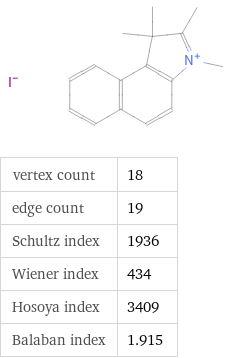
vertex count | 18 edge count | 19 Schultz index | 1936 Wiener index | 434 Hosoya index | 3409 Balaban index | 1.915
Estimated thermodynamic properties
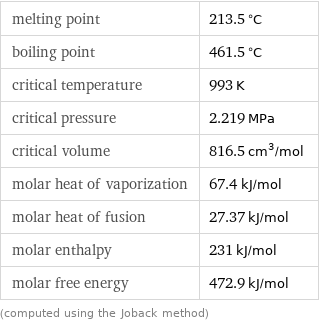
melting point | 213.5 °C boiling point | 461.5 °C critical temperature | 993 K critical pressure | 2.219 MPa critical volume | 816.5 cm^3/mol molar heat of vaporization | 67.4 kJ/mol molar heat of fusion | 27.37 kJ/mol molar enthalpy | 231 kJ/mol molar free energy | 472.9 kJ/mol (computed using the Joback method)
Units

Quantitative molecular descriptors
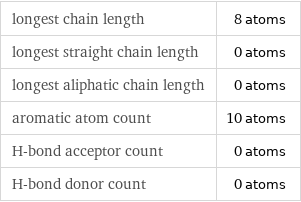
longest chain length | 8 atoms longest straight chain length | 0 atoms longest aliphatic chain length | 0 atoms aromatic atom count | 10 atoms H-bond acceptor count | 0 atoms H-bond donor count | 0 atoms
Elemental composition
![Find the elemental composition for 1, 1, 2, 3-tetramethyl-1 h-benz[e]indolium iodide in terms of the atom and mass percents: atom percent = N_i/N_atoms × 100% mass percent = (N_im_i)/m × 100% Plan: • Write the chemical formula and gather atomic masses from the periodic table. • Determine values for N_i, m_i, N_atoms and m using these items. • Finally, compute the percents and check the results. Write the chemical formula: C_16H_18IN Use the chemical formula, C_16H_18IN, to count the number of atoms, N_i, for each element and find the total number of atoms, N_atoms: | number of atoms I (iodine) | 1 C (carbon) | 16 N (nitrogen) | 1 H (hydrogen) | 18 N_atoms = 1 + 16 + 1 + 18 = 36 Divide each N_i by N_atoms to calculate atom fractions. Then use the property that atom fractions must sum to one to check the work: | number of atoms | atom fraction I (iodine) | 1 | 1/36 C (carbon) | 16 | 16/36 N (nitrogen) | 1 | 1/36 H (hydrogen) | 18 | 18/36 Check: 1/36 + 16/36 + 1/36 + 18/36 = 1 Compute atom percents using the atom fractions: | number of atoms | atom percent I (iodine) | 1 | 1/36 × 100% = 2.78% C (carbon) | 16 | 16/36 × 100% = 44.4% N (nitrogen) | 1 | 1/36 × 100% = 2.78% H (hydrogen) | 18 | 18/36 × 100% = 50.0% Look up the atomic mass, m_i, in unified atomic mass units, u, for each element in the periodic table: | number of atoms | atom percent | atomic mass/u I (iodine) | 1 | 2.78% | 126.90447 C (carbon) | 16 | 44.4% | 12.011 N (nitrogen) | 1 | 2.78% | 14.007 H (hydrogen) | 18 | 50.0% | 1.008 Multiply N_i by m_i to compute the mass for each element. Then sum those values to compute the molecular mass, m: | number of atoms | atom percent | atomic mass/u | mass/u I (iodine) | 1 | 2.78% | 126.90447 | 1 × 126.90447 = 126.90447 C (carbon) | 16 | 44.4% | 12.011 | 16 × 12.011 = 192.176 N (nitrogen) | 1 | 2.78% | 14.007 | 1 × 14.007 = 14.007 H (hydrogen) | 18 | 50.0% | 1.008 | 18 × 1.008 = 18.144 m = 126.90447 u + 192.176 u + 14.007 u + 18.144 u = 351.23147 u Divide the mass for each element by m to calculate mass fractions. Then use the property that mass fractions must sum to one to check the work: | number of atoms | atom percent | mass fraction I (iodine) | 1 | 2.78% | 126.90447/351.23147 C (carbon) | 16 | 44.4% | 192.176/351.23147 N (nitrogen) | 1 | 2.78% | 14.007/351.23147 H (hydrogen) | 18 | 50.0% | 18.144/351.23147 Check: 126.90447/351.23147 + 192.176/351.23147 + 14.007/351.23147 + 18.144/351.23147 = 1 Compute mass percents using the mass fractions: Answer: | | | number of atoms | atom percent | mass percent I (iodine) | 1 | 2.78% | 126.90447/351.23147 × 100% = 36.13% C (carbon) | 16 | 44.4% | 192.176/351.23147 × 100% = 54.71% N (nitrogen) | 1 | 2.78% | 14.007/351.23147 × 100% = 3.988% H (hydrogen) | 18 | 50.0% | 18.144/351.23147 × 100% = 5.166%](../image_source/f2da5d75d3f1edf1fb50a62845a9f277.png)
Find the elemental composition for 1, 1, 2, 3-tetramethyl-1 h-benz[e]indolium iodide in terms of the atom and mass percents: atom percent = N_i/N_atoms × 100% mass percent = (N_im_i)/m × 100% Plan: • Write the chemical formula and gather atomic masses from the periodic table. • Determine values for N_i, m_i, N_atoms and m using these items. • Finally, compute the percents and check the results. Write the chemical formula: C_16H_18IN Use the chemical formula, C_16H_18IN, to count the number of atoms, N_i, for each element and find the total number of atoms, N_atoms: | number of atoms I (iodine) | 1 C (carbon) | 16 N (nitrogen) | 1 H (hydrogen) | 18 N_atoms = 1 + 16 + 1 + 18 = 36 Divide each N_i by N_atoms to calculate atom fractions. Then use the property that atom fractions must sum to one to check the work: | number of atoms | atom fraction I (iodine) | 1 | 1/36 C (carbon) | 16 | 16/36 N (nitrogen) | 1 | 1/36 H (hydrogen) | 18 | 18/36 Check: 1/36 + 16/36 + 1/36 + 18/36 = 1 Compute atom percents using the atom fractions: | number of atoms | atom percent I (iodine) | 1 | 1/36 × 100% = 2.78% C (carbon) | 16 | 16/36 × 100% = 44.4% N (nitrogen) | 1 | 1/36 × 100% = 2.78% H (hydrogen) | 18 | 18/36 × 100% = 50.0% Look up the atomic mass, m_i, in unified atomic mass units, u, for each element in the periodic table: | number of atoms | atom percent | atomic mass/u I (iodine) | 1 | 2.78% | 126.90447 C (carbon) | 16 | 44.4% | 12.011 N (nitrogen) | 1 | 2.78% | 14.007 H (hydrogen) | 18 | 50.0% | 1.008 Multiply N_i by m_i to compute the mass for each element. Then sum those values to compute the molecular mass, m: | number of atoms | atom percent | atomic mass/u | mass/u I (iodine) | 1 | 2.78% | 126.90447 | 1 × 126.90447 = 126.90447 C (carbon) | 16 | 44.4% | 12.011 | 16 × 12.011 = 192.176 N (nitrogen) | 1 | 2.78% | 14.007 | 1 × 14.007 = 14.007 H (hydrogen) | 18 | 50.0% | 1.008 | 18 × 1.008 = 18.144 m = 126.90447 u + 192.176 u + 14.007 u + 18.144 u = 351.23147 u Divide the mass for each element by m to calculate mass fractions. Then use the property that mass fractions must sum to one to check the work: | number of atoms | atom percent | mass fraction I (iodine) | 1 | 2.78% | 126.90447/351.23147 C (carbon) | 16 | 44.4% | 192.176/351.23147 N (nitrogen) | 1 | 2.78% | 14.007/351.23147 H (hydrogen) | 18 | 50.0% | 18.144/351.23147 Check: 126.90447/351.23147 + 192.176/351.23147 + 14.007/351.23147 + 18.144/351.23147 = 1 Compute mass percents using the mass fractions: Answer: | | | number of atoms | atom percent | mass percent I (iodine) | 1 | 2.78% | 126.90447/351.23147 × 100% = 36.13% C (carbon) | 16 | 44.4% | 192.176/351.23147 × 100% = 54.71% N (nitrogen) | 1 | 2.78% | 14.007/351.23147 × 100% = 3.988% H (hydrogen) | 18 | 50.0% | 18.144/351.23147 × 100% = 5.166%
Elemental oxidation states
![The first step in finding the oxidation states (or oxidation numbers) in 1, 1, 2, 3-tetramethyl-1 h-benz[e]indolium iodide is to draw the structure diagram. Next set every oxidation number equal to the atom's formal charge: In 1, 1, 2, 3-tetramethyl-1 h-benz[e]indolium iodide hydrogen is not bonded to a metal with lower electronegativity, so it will have an oxidation state of +1. Any element bonded to hydrogen gains the bonding electrons, decreasing their oxidation state by 1 for every bond: With hydrogen out of the way, look at the remaining bonds. There are 3 carbon-nitrogen bonds, and 16 carbon-carbon bonds. For each of these bonds, assign the bonding electrons to the most electronegative element. First examine the carbon-nitrogen bonds: element | electronegativity (Pauling scale) | C | 2.55 | N | 3.04 | | | Since nitrogen is more electronegative than carbon, the electrons in these bonds will go to nitrogen. Decrease the oxidation number for nitrogen in every highlighted bond (by 1 for single bonds, 2 for double bonds, and 3 for triple bonds), and increase the oxidation number for carbon accordingly: Next look at the carbon-carbon bonds: element | electronegativity (Pauling scale) | C | 2.55 | C | 2.55 | | | Since these elements are the same the bonding electrons are shared equally, and there is no change to the oxidation states: Now summarize the results: Answer: | | oxidation state | element | count -3 | C (carbon) | 3 | N (nitrogen) | 1 -2 | C (carbon) | 1 -1 | C (carbon) | 6 | I (iodine) | 1 0 | C (carbon) | 4 +1 | C (carbon) | 1 | H (hydrogen) | 18 +2 | C (carbon) | 1](../image_source/5f4d11bdfc49fb3cfa58dc5f0e02659e.png)
The first step in finding the oxidation states (or oxidation numbers) in 1, 1, 2, 3-tetramethyl-1 h-benz[e]indolium iodide is to draw the structure diagram. Next set every oxidation number equal to the atom's formal charge: In 1, 1, 2, 3-tetramethyl-1 h-benz[e]indolium iodide hydrogen is not bonded to a metal with lower electronegativity, so it will have an oxidation state of +1. Any element bonded to hydrogen gains the bonding electrons, decreasing their oxidation state by 1 for every bond: With hydrogen out of the way, look at the remaining bonds. There are 3 carbon-nitrogen bonds, and 16 carbon-carbon bonds. For each of these bonds, assign the bonding electrons to the most electronegative element. First examine the carbon-nitrogen bonds: element | electronegativity (Pauling scale) | C | 2.55 | N | 3.04 | | | Since nitrogen is more electronegative than carbon, the electrons in these bonds will go to nitrogen. Decrease the oxidation number for nitrogen in every highlighted bond (by 1 for single bonds, 2 for double bonds, and 3 for triple bonds), and increase the oxidation number for carbon accordingly: Next look at the carbon-carbon bonds: element | electronegativity (Pauling scale) | C | 2.55 | C | 2.55 | | | Since these elements are the same the bonding electrons are shared equally, and there is no change to the oxidation states: Now summarize the results: Answer: | | oxidation state | element | count -3 | C (carbon) | 3 | N (nitrogen) | 1 -2 | C (carbon) | 1 -1 | C (carbon) | 6 | I (iodine) | 1 0 | C (carbon) | 4 +1 | C (carbon) | 1 | H (hydrogen) | 18 +2 | C (carbon) | 1
Orbital hybridization

hybridization | element | count sp^2 | C (carbon) | 11 | N (nitrogen) | 1 sp^3 | C (carbon) | 5
Structure diagram
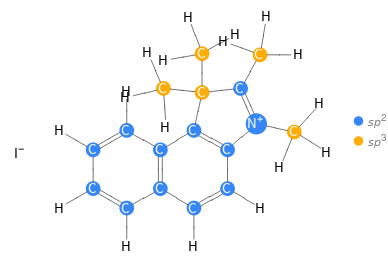
Orbital hybridization Structure diagram
Topological indices
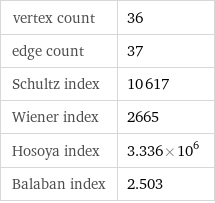
vertex count | 36 edge count | 37 Schultz index | 10617 Wiener index | 2665 Hosoya index | 3.336×10^6 Balaban index | 2.503